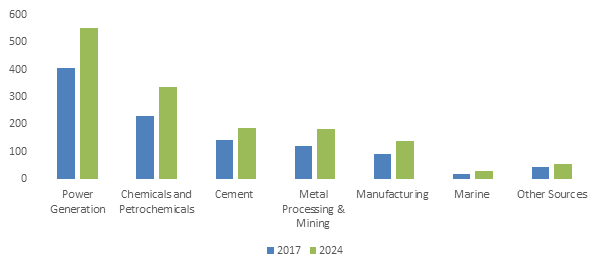Wet Electrostatic Precipitator (ESP) Market to accumulate significant revenue over 2016-2024, increasing applications in paper & pulp sector to drive product demand
Publisher : Fractovia | Published Date : 2017-04-04Request Sample
Increasing pollutant emissions have mandated the usage of ESPs in industries, thereby benefitting global electrostatic precipitator market. Growing environmental concerns regarding harmful pollutant and dust emissions have urged the government to implement stringent norms and directives to regulate toxic emissions, which in turn will significantly propel the industry trends. According to Global Market Insights, Inc., Electrostatic Precipitator Market is anticipated to be valued at more than USD 8 billion by 2024, increasing at a CAGR of 5% over 2016-2024.”
Electrostatic precipitators are primarily used to filter out fine particles from a flowing gas unit. This is done by means of an induced electrostatic charge that collects the fine particles without causing lasting harm to the flow of gases through the unit. Rising expenditure on the construction and infrastructural development sectors, strict government regulations to curb air pollution, and high demand from the power plant and chemical factories are the key factors that will positively favor electrostatic precipitator industry trends.
U.S. Electrostatic Precipitators (ESP) Market Size, by application 2013-2024 (USD Million)

ESPs are amply used to collect pollute particles in industries that are notorious for emitting harmful pollutants, such as cement, metal, manufacturing, chemical and petrochemical, and power plants.
Chemical and petrochemical applications covered more than 20% of global electrostatic precipitator market share in 2015. Petroleum products such as lubricants, LPG, asphalts, and diesel are increasingly used in petrochemical factories for various industrial applications. High demand for these products will augment electrostatic precipitator industry from chemical and petrochemical applications.
The ever-growing demand for uninterrupted power supply will positively influence ESP market size from power plant applications, which was worth more than USD 1 billion in 2015. Power plants emit high amounts of toxic pollutants that are harmful for the environment. Carbon, pollutants, and GHG emissions from power plants will necessitate the usage of ESPs in this sector. In addition, the adoption of government measures to curb these emissions will also complement industry growth.
Technologically advanced products are being introduced in the manufacturing sector, in accordance with the changing consumer dynamics, which will boost ESP market from manufacturing applications. Additionally, the altering economics of production and distribution will also fuel the industry trends.
Electrostatic precipitator market from cement applications was worth more than USD 700 million in 2015. Cement applications contributed to more than 13% of the overall revenue share and is poised to witness a y-o-y growth of 4% over 2016-2024. This growth rate can be attributed to the high spending on infrastructural development as well as the rising product demand across the commercial, industrial, and residential sectors.
The presence of a huge number of manufacturing industries is also expected to augment China electrostatic precipitator industry, which contributed to more than 3% of the regional revenue share in 2015.
Coal fire power plants emit harmful Sulphur trioxide and other pollutants. Strict measures to curb these emissions coupled with the rising installations of coal fired power plants will also boost China ESP market significantly.
Europe electrostatic precipitator industry is likely to be driven by the rapid restoration of the current manufacturing sector. Given that the UK government has laid down strict norms towards the eradication of air pollution, UK electrostatic precipitator market will grow at a steep CAGR of more than 6% from 2016 to 2024. The implementation of colossal power projects is also bound to favor business growth.
Germany ESP industry, worth more than USD 240 million in 2015, is slated to observe an exponential growth rate of more than 5% over 2016-2024.
U.S. held more than 60% of North America electrostatic precipitator market share in 2015, and is anticipated to record a revenue of more than USD 1 billion by 2024. High demand for renovating the existing infrastructural framework will contribute to the regional expansion. In addition, this region houses some of the most notable industry players, who are constantly striving to generate awareness pertaining to ESP system installation and upgradation. This will further fuel business growth in the region.
Wet ESPs helps to gather moist, sticky, highly resistive, flammable, and explosive particles with a score of more than 90% on the efficiency scale, owing to which these products find extensive applications in the textile, manufacturing, and the paper and pulp sectors. Wet electrostatic precipitator market held a revenue of more than USD 500 million in 2015 and will amass considerable gains over 2016-2024, driven by the product property to collect miniscule particles with exceptional efficiency.
Dry ESPs help collect dry pollutant particles with nearly 100% efficiency. In addition, these products possess the benefits of low operating costs and less maintenance. Dry electronic precipitator industry, having held a revenue of USD 4 billion in 2015, is slated to observe an exponential growth of 5% over 2016-2024.
Notable players operating in electrostatic precipitator industry include Blacke-Durr GmbH, Mitsubishi Heavy Industries Mechatronics Systems, GEECO Enercon Pvt. Ltd, Fujian Longking Co., Ltd., Trion Inc., Babcock & Wilcox Enterprises, Hamon Corporation, Siemens AG, Thermax Ltd., Clean Tunnel Air International AS, Total Air Pollution Control Pty. Ltd., and Ducon Technologies Inc.